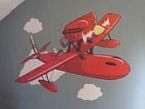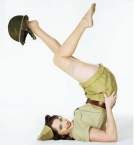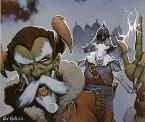SenToku
Posts: 57
Joined: 11/29/2012
Status: offline

|
Here goes my personal opinions on CV TF composition. As JFB I am more familiar with IJN, but most advice works for both.
First; to max out offensive capabilities, cordinated strikes are must. Disorganized strikes in 1942 for USN or later for IJN can easily be shot down by superior CAP planes of your opponent.
To get cordinated strikes you first need to have plane count on TF smaller than the random numbers mentioned on manual page 167. I try to keep max number of planes in single TF at bellow limit for 75% chance of full strike (250 planes/TF for IJN).
For USN this 75% limit would limit the plane count on TF to 125 in '42, about 185 in '43 and 250 after '44.
Second, you need a good Air skill on your TF commander. Remember, Air Combat TF's commander is equal to Air HQ commander for planes in the TF and thus the air skill determines number of strike/patrol aircraft launching. I have an impression that Air skill of HQ/CV TF has no effect on CAP planes. Not too sure about that, but seem to remember it that way.
For more planes, you need multiple TF's. To get past problem mentioned by crsutton and others (only one TF reacting), easiest thing is to place ALL CV TF's on follow and create an ASW TF to lead them all. Follower TF's do not react and you can move them all just by issuing orders to the ASW TF. I like to make the CV's trail the ASW by hex or so, just to make sure that ASW is the first TF over any sub on route. Added bonus is "free" bait TF for enemy planes, so if you are lucky some enemy bombers go after your tin cans instead of the bird farms.
As for composition,one thing not mentioned here is Max Speed. Sometimes it pays to do a fast dash with carriers, either to get away or intercept and then the max speed matching might determine the winner.
So placing all the fast IJN carriers (Shokaku, Zuikaku, Hiryo and Soryo) along the Tone-class "escort" cruisers and fast DD's in one TF, creates fastest CV TF in game (34 kts). This is 4 hexes/turn faster than US CV TF (8 hexes, if opponent has BB in that TF) capable of hitting a target well beyond Allied patrol plane range (=complete surprise). Thus my ideal combo in 1942 would be KB with two TF's; 1st Division with all the fast ones and 2nd with all the rest. All following single ASW TF. Plane count in mid 1942 withing limit and fast 1st division can seperate and do a fast dash at any moment.
USN has less variety in their ships, but for defensive purposes I would be carefull with BB's in TF at least in 1942. While it increases the AA values, it might be the reason I need AA in the first place. My feel is that it should not be used on "raid" - type missions, where I am hitting a target and getting away. On landing supports and set battles it would be different story. If I leave BB's away, I try to compensate with CA's. Mainly to deter any surface actions.
I handle ASW with seperate ASW TF's, including the "Tow"- TF which CV TFs are following, trusting them to take some load from CV-TF and allowing less dedicated ASW ships with CVs themselves. For USN these ASW platforms could be older models, especially the LR DE versions with range almost as good as CV's themselves. Lower top speed of escorts in seperate ASW screen does not matter, since CVs can ditch the screen anytime they need to. Also since screen is the first over any sub, there is less chance of getting torps on important parts, such as flatops. Even if sub is not hit/sunk, or even if sub sinks an escort, it still has increased DL by the time CV's come around.
|
 Printable Version
Printable Version









 New Messages
New Messages No New Messages
No New Messages Hot Topic w/ New Messages
Hot Topic w/ New Messages Hot Topic w/o New Messages
Hot Topic w/o New Messages Locked w/ New Messages
Locked w/ New Messages Locked w/o New Messages
Locked w/o New Messages Post New Thread
Post New Thread